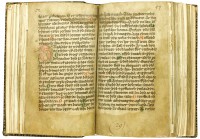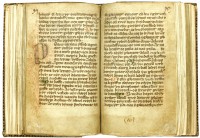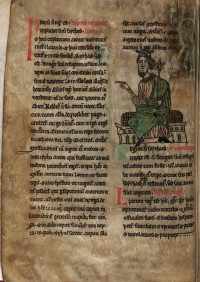In a delightful change of pace from the way these stories usually go, a rare 14th century Welsh manuscript of enormous historical import was sold at auction earlier this month and purchased not by an anonymous private collector, but by a public institution in its country of origin where it is now on display for all to see. The manuscript is a pocket-sized bound volume of the Laws of Hywel Dda, a 10th century compendium of laws codified by Welsh King Hywel Dda, a.k.a. Hywel the Good, and it was purchased by the National Library of Wales in Aberystwyth for $840,000 at a Sotheby’s auction in London on July 10th. The seller was the Massachusetts Historical Society in Boston.
 The earliest surviving manuscripts of the Laws of Hywel Dda date to the mid-13th century, so this particular copy is just 100 years newer than the oldest ones in existence. The language itself is also extremely rare. There are only 80 manuscripts written in medieval Welsh known to survive. It’s been nearly a century since a medieval Welsh language manuscript was offered for public sale, and this one is the earliest ever sold.
The earliest surviving manuscripts of the Laws of Hywel Dda date to the mid-13th century, so this particular copy is just 100 years newer than the oldest ones in existence. The language itself is also extremely rare. There are only 80 manuscripts written in medieval Welsh known to survive. It’s been nearly a century since a medieval Welsh language manuscript was offered for public sale, and this one is the earliest ever sold.
Experts believe the manuscript was written by a professional scribe for an itinerant lawyer to carry with him and use in his practice. There are handwritten notes indicating the books’ practical use as a reference and living document. Somehow, from 14th century Wales, the manuscript wound up in the hands of the Massachusetts Historical Society of Boston. Researchers have an idea of its winding path, but no explicit evidence.
The first appearance of the manuscript in the historical record is a reference by antiquarian Edward Llwyd in his 1707 book Archaeologia Britannica. He says the manuscript was discovered in Brecon, South Wales, in the library of town official and barrister William Phillips. William Wotton, the first editor and translator of Welsh laws, used it as a source for his work in 1721. That same year, Phillips died, leaving his library to his daughter Anne and her husband William Scourfield of New Moat, Pembrokeshire.
 A Morris Scourfield from Narbeth, Pembrokeshire, just eight miles from New Moat, was one of the first people to buy land in the Pennsylvania Welsh community. The last name is rare and his point of origin strongly suggests that Morris was a descendant of William. He or one of his relations most likely brought the manuscript of the Laws of Hywel Dda with them to America in the second half of the 18th century. The Massachusetts Historical Society thinks they received it as a gift in the 19th century, but they don’t have a complete record on the donation.
A Morris Scourfield from Narbeth, Pembrokeshire, just eight miles from New Moat, was one of the first people to buy land in the Pennsylvania Welsh community. The last name is rare and his point of origin strongly suggests that Morris was a descendant of William. He or one of his relations most likely brought the manuscript of the Laws of Hywel Dda with them to America in the second half of the 18th century. The Massachusetts Historical Society thinks they received it as a gift in the 19th century, but they don’t have a complete record on the donation.
The Laws were Wales’ first codified uniform legal system. Many of them focus on restorative principles, establishing monetary values for everything from property to household pets to body parts so that any damage or theft would be resolved by payment. Some of them are somewhat progressive in their approach towards women’s rights, in marked contrast to contemporary laws in Anglo-Saxon and Norman England. For instance, the dowry was the amount of a married couple’s communal property which would belong only to the wife should the couple break up before seven years. The amount was determined solely by her social status. Should they break up after seven years, she was entitled to half of their communal property. Women could own, buy and sell property. Women could not be forced to remain in a marriage they wished to leave.
On the other hand, women were not allowed to be enlisted as witnesses for or against a man, and they could be legally beaten by their husbands for three reasons: 1) for giving away something that they did not exclusively own, 2) for being caught in adulterous embraces, 3) for wishing a blemish on her husband’s beard. Beards were a big thing with them. They come up repeatedly.
This unique and fascinating legal system is a key element in Welsh identity, culture and history. Before Hywel’s time, Wales was divided and ruled by a number of kings at a time. Hywel ruled almost the entirety of Wales excepting solely the southeastern regions of Morgannwg and Gwent. His laws were an important unifying factor bringing the country under a single set of administrative rules. When King Edward I of England conquered Wales in 1283, he attempted to eradicate most native legal practices to make the Welsh subject to English law. That this manuscript was commissioned and put to active use 70 years later shows that the Welsh still practiced their way, Longshanks and his heirs be damned.
 You see why, therefore, it was of particular importance that this manuscript not wind up in some anonymous collection — especially a British one — never to be seen again. The National Library of Wales secured a grant of $723,000 from the Heritage Lottery Fund to buy the manuscript, and the rest of the money came from the library’s own budget and the Welsh government.
You see why, therefore, it was of particular importance that this manuscript not wind up in some anonymous collection — especially a British one — never to be seen again. The National Library of Wales secured a grant of $723,000 from the Heritage Lottery Fund to buy the manuscript, and the rest of the money came from the library’s own budget and the Welsh government.
The Laws of Hywel Dda are on public view at the National Library of Wales’ Hengwrt Room from July 23rd until August 31st. After that, the manuscript will be removed for study, conservation and digitization. It will make an excellent companion to a whimsically illustrated Latin manuscript of the Laws they’ve already digitized. The library expects they’ll be done by the end of 2012, whereupon the digitized manuscript will be uploaded to their website and the original manuscript will go on permanent display in the rare book gallery.